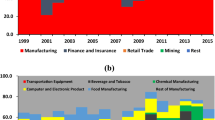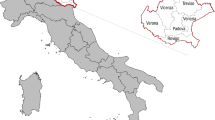Abstract
Firm-level data sets on foreign manufacturing plants in four Central and Eastern European Countries are used in this paper, to trace their location and estimate the determinants of their choice processes. A nested logit model as developed by McFadden (1974) is used in the analysis. A central focus of the analysis is foreign direct investment (FDI) which is a good indicator of where location of foreign investments is made. Several reasons explain the need for mapping the location of FDI. First of all, it facilitates understanding the real competitiveness of regions and countries in providing location advantages able to complement multi-national enterprises’ (MNE) specific advantages. Secondly, it directly shows the distribution of the benefits usually associated with FDI. Finally, an understanding of FDI location decisions is important for policy makers who believe that MNEs may offer a positive contribution to the economic development of disadvantaged areas and thus correct potential regional imbalances. The main results show that sector specific factors affect the choice of the final location. These unobserved characteristics influence both the determinants and the structure of MNEs location choice process.
Similar content being viewed by others
References
Barrios S, Gorg H, Strobl E (2003) Multinationals’ location choice, agglomeration economies and public incentives. CORE Discussion paper no. 17
Bartik T (1985) Business location decisions in the United States: estimates of the effects of unionization, taxes, and other characteristics of states. J Bus Econ Stat 3(1):14–22
Basile R, Castellani D, Zanfei A (2003) Location choices of multinational firms in Europe: the role of national boundaries and EU policy. Università degli studi di Urbino, Facoltà di economia, working paper no. 78
Bekes G (2004) Location of manufacturing FDI in Hungary: how important are business to business relationships? mimeo
Braunerhjelm P, Svensson R (1996) Host country characteristics and agglomeration in foreign direct investment. Appl Econ 28:833–840
Blomstrom M, Kokko A (1997) How foreign investment affects host countries. World Bank, Policy Research Working Paper no. 1745
Capello R (2007) Regional economics. London, Routledge
Carlton D (1983) The location and employment choices of new firms: an econometric model with discrete and continuous endogenous variables. Rev Econ Stat 65:440–449
Chung W, Alcacer J (2002) Knowledge seeking and location choice of foreign direct investment in the United States. Manage Sci 48(12):1534–1554
Coughlin C, Terza J, Arromdee V (1991) State characteristics and the location of foreign direct investment within the United States. Rev Econ Stat 73:675–683
Daly A, Zachary S (1979) Improved multiple choice models. In: Hensher D, Dalvi Q (eds) Identifying and measuring the determinants of mode choice. Teakfield, London
Disdier AC, Mayer T (2003) How different is Eastern Europe? Structure and determinants of location choices by French firms in Eastern and Western Europe. J Comp Econ 32(2):280–296
Dunning J (1977) Trade, location of economic activity and MNE: a search for an eclectixc approach. In: Ohlin B, Hesselborn P, Wijkman (eds) The international allocation of economic activity. MacMillan, London
Fischer M, Nijkamp P (1987) From static towards dynamic discrete choice modelling. A state of the art review. Reg Sci Urban Econ 17:3–27
Friedman J, Gerlowski D, Silberman J (1992) What attracts foreign multinational corporations? Evidence from branch plant location in the United States. J Reg Sci 32(4):403–418
Fujita M, Krugman P, Venables A (2000), The Spatial economy: cities, regions and international trade. MIT Press, Cambridge
Fujita M, Thisse J (2002) Economics of agglomeration. Cambridge University Press, Cambridge
Green WH (2003) Econometric analysis. Prentice-Hall, New Jersey
Greenhut M (1959) Size of the markets versus transport costs in industrial location surveys and theory. J Ind Econ 8:172–184
Guimarães P, Figueiredo O, Woodward D (2000a) A tractable approach to the firm location decision problem. mimeo
Guimarães P, Figueiredo O, Woodward D (2000b) Agglomeration and the location of foreign direct investment in Portugal. J Urban Econ 47:115–135
Guimarães P, Figueiredo O, Woodward D (2002) Modelling industrial location decisions in US counties. NIMA, Universidade do Minho, working paper series no. 18
Hansen E (1987) Industrial location choice in Saõ Paulo, Brazil. A nested logit model. Reg Sci Urban Econ 17:89–108
Harris C (1954) The market as a factor in the localization of industry in the United States. Ann Assoc Am Geogr 64:315–348
Head C, Ries J, Swenson D (1999) Attracting foreign manufacturing: investment promotion and agglomeration. Reg Sci Urban Econ 29:197–218
Head K, Mayer T (2004) Market potential and the location of Japanese investment in the European Union. Rev Econ Stat 86(4):959–72
Herriges J, Kling C (1995) An empirical investigation of the consistency of nested logit models with utility maximization. Am J Agric Econ I 77:875–884
Herriges J, Kling C (1996) Testing the consistency of nested logit models with utility maximization. Econ Lett 50(1):33–39
Hogenbirk A, Narula R (2004) Location and agglomeration of FDI in The Netherlands: implications for policy. MERIT—infonomics research memorandum series no. 006
Krugman P (1991) Increasing returns and economic geography. J Polit Econ 99(3):484–499
Lee B (1999) Calling patterns and usage of residential toll service under self selecting tariffs. J Regul Econ 16:45–81
Louviere J, Henscher D, Swait J (2000) Stated choice method. Cambridge University Press, Cambridge
McCann P (2002) Classical and neoclassical location-production models. In: McCann P (ed) Industrial location economics. Cheltenham, Edward Elgar
McFadden D (1974) Conditional logit analysis of qualitative choice behaviour. In: Zarembka P (ed) Frontiers in econometrics Academic, New York, pp 105–142
McFadden D (1978) Modelling the choice of residential location. In: Karlquist A, Lundquist L, Snickars F, Weibull JW (eds) Spatial interaction theory and planning models. North-Holland Publ. Co., Amsterdam, pp 75–96
Markusen J (1995) The boundaries of multinational enterprises and the theory of International trade. J Econ Perspect 9(2):169–189
Mucchielli JL, Puech F (2004) Globalization, agglomeration and FDI location: the case of French firms in Europe. In: Mucchielli JL, Mayer T (eds) Multinational firms’ location and the new economic geography. Edward Elgar, Cheltenham, pp 35–58
Ottaviano GI (2003) Regional policy in the global economy: insights from the New Economic Geography. Reg Stud 37(6–7):665–674
Resmini L (2003) Economic integration, industry location and frontiers economies in transition countries. Econ Syst 27:204–221
Resmini L (2004) Economic integration and industry location in transition countries. ZEI working paper no. B-10
Schmenner R, Huber J, Cook R (1987) Geographic differences and the location of new manufacturing facilities. J Urban Econ 21:83–104
Szalavetz A (2004) The role of FDI in fostering agglomeration and regional structural change in Hungary. EURECO working paper
Train K (1980) A structured logit model of auto ownership and mode choice. Rev Econ Stud 47:357–370
Train K (1986) Qualitative choice analysis: theory, econometrics and an application to the automobile demand MIT Press, Cambridge
Train K (2003) Discrete choice methods with simulation. Cambridge University Press, Cambridge
Train K, MacFadden D, Ben-Akiva M (1987) The demand for local telephone service: a fully discrete model of residential calling patterns and service choices. Rand J Econ 18(1):109–123
UNCTAD (2004) World investment report. United Nation, Geneva
UN-ECE (2001) Economic growth and foreign direct investments in the transition economies, chap 5, vol 1 Econ Surv Eur
Weber A (1929) Alfred Weber’s theory of the location of industries, Chicago, Ill., University of Chicago Press; translated from the original Über der Standort der Industrien, Tübingen, Mohr, 1909
Wisniewski A (2004) The impact of foreign direct investment on regional development. The case of Poland. EURECO working paper
Author information
Authors and Affiliations
Corresponding author
Additional information
This paper has been written as a part of the Research Network on “The Impact of the European Integration and Enlargement on Regional Structural Change and Cohesion”, financed by the European Commission through the 5th Framework Programme. The authors are grateful to the other members of the Research Consortium and the participants at the international workshop “Modelling the Entrepreneurial and Innovative Space-Economy” organized by the Tinbergen Institute on 22–23 August 2005 for very helpful comments and suggestions provided on an earlier version of this work.
Rights and permissions
About this article
Cite this article
Pusterla, F., Resmini, L. Where do foreign firms locate in transition countries? An empirical investigation. Ann Reg Sci 41, 835–856 (2007). https://doi.org/10.1007/s00168-007-0144-4
Received:
Accepted:
Published:
Issue Date:
DOI: https://doi.org/10.1007/s00168-007-0144-4




